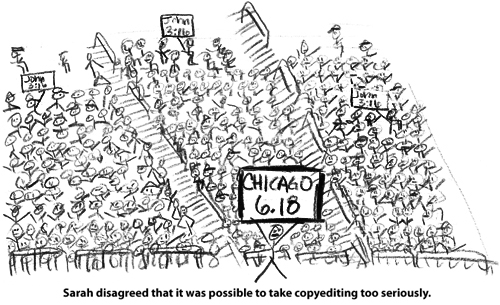| Sun | Mon | Tue | Wed | Thu | Fri | Sat |
|---|---|---|---|---|---|---|
| 1 | 2 | 3 | 4 | 5 | ||
| 6 | 7 | 8 | 9 | 10 | 11 | 12 |
| 13 | 14 | 15 | 16 | 17 | 18 | 19 |
| 20 | 21 | 22 | 23 | 24 | 25 | 26 |
| 27 | 28 | 29 | 30 | 31 |
CATEGORIES
RECENT ENTRIES
BLOG ROLL
Out of the question
Where there's a fastidious editor, you'll also find the Chicago Manual of Style (CMS for short).
When my father was a professor at the University of Missouri, he kept his worn Manual on an off-limits bookshelf next to blandly bound academic journals. My high-school journalism teacher Mrs. H nestled her beloved copy between other references she shared with students. I bought my copy (the 14th edition) during college, but the practical guide's presence in my life didn't end there. Throughout 2003, I coveted a stylish black canvas bag featuring the cover of the 15th edition that Magazine editor Mary Ruth Yoe used to carry her belongings to and from the office. As I type this entry, I only have to turn my head to glimpse a new copy of the reference book on my cubemate's desk.
I get my inner grammar-nerd fix by lurking around the Manual's official Web site, where a straightforward, scholarly question-and-answer—which debuted in 1997—is published by editors under the leadership of Carol Fisher Saller, a senior manuscript editor in the books division of the University of Chicago Press.
Each month, visitors to the press's Web site submit several hundred questions related to the Manual's grammar and writing rules. From this pool, Saller's team reviews the submissions and picks out creative and complicated questions with hard-to-find answers. Laura Andersen, a senior promotions manager who has been with the press for five years, estimates that around 90 percent of the questions could be easily answered by referring to the Manual. "Readers are most concerned with how to cite sources," says Andersen. "Hyphenation issues are popular. Whether to capitalize job titles, whether to use a comma, whether to spell out numbers—these are the most frequently asked questions."
Manual fans in the Magazine's offices and beyond are hooked on the more obscure queries that make the cut. The result, called the Chicago Style Q&A, continues to grow in popularity. The free Q&A was profiled in the Reader in the spring of 2007. Earlier that same year, Harper's editors reprinted a page of their favorites under the title 'Stet Offensive' that "made us sound like a bunch of comedians," says Andersen.
It's hard not to chuckle at the dry humor in the answers. The press's three favorite pairings are proof:
About two spaces after a period. As a U.S. Marine, I know that what’s right is right and you are wrong. I declare it once and for all aesthetically more appealing to have two spaces after a period. If you refuse to alter your bullheadedness, I will petition the commandant to allow me to take one Marine detail to conquer your organization and impose my rule. Thou shalt place two spaces after a period. Period. Semper Fidelis.
As a U.S. Marine, you’re probably an expert at something, but I’m afraid it’s not this. Status quo.
The menu in our cafeteria shows that enchiladas are available “Tues.–Fri.” However, when I ordered one on a Wednesday, I was informed that enchiladas are available on Tuesday and Friday, not Tuesday through Friday. When I informed the cafeteria manager that this was incorrect, she seemed shocked and refused to change the sign. Please help determine who is correct.
Although the sign was incorrect, I’m not sure you should annoy the person who provides the enchiladas.
Oh, English-language gurus, is it ever proper to put a question mark and an exclamation mark at the end of a sentence in formal writing? This author is giving me a fit with some of her overkill emphases, and now there is this sentence that has both marks at the end. My everlasting gratitude for letting me know what I should tell this person.
In formal writing, we allow both marks only in the event that the author was being physically assaulted while writing. Otherwise, no.
The Press will release the 16th edition of the Manual in both cloth and online formats in fall 2010. Until then the press editors advise, "Read the Manual carefully and keep it close—but don't be afraid to bend the rules occasionally."
J.O.M.
January 7, 2009

